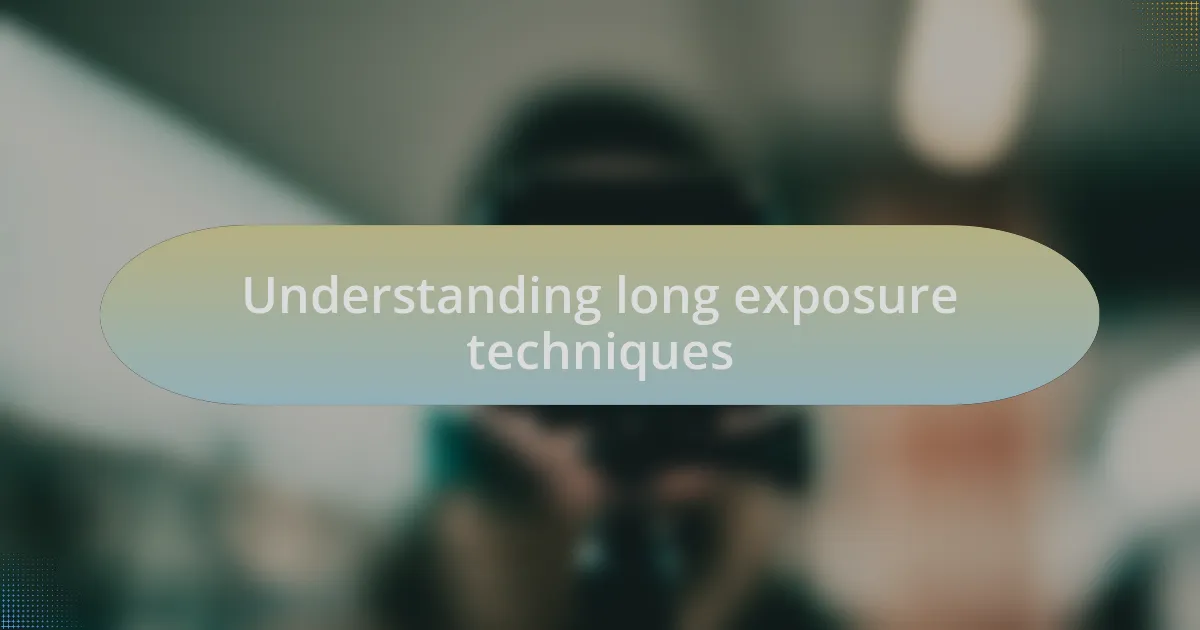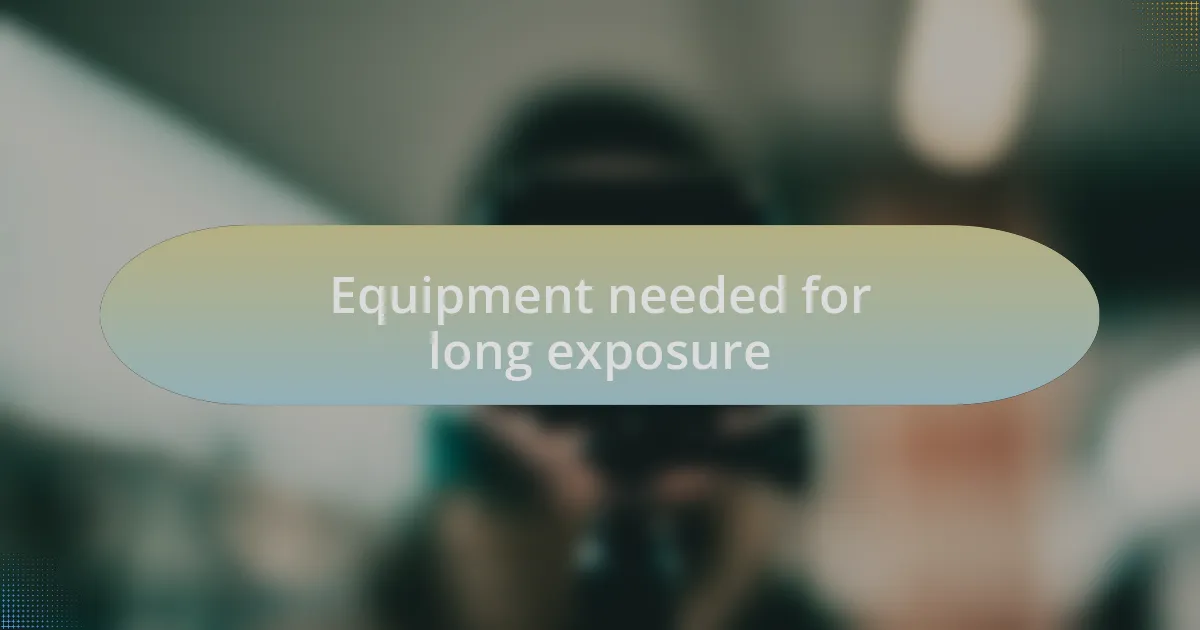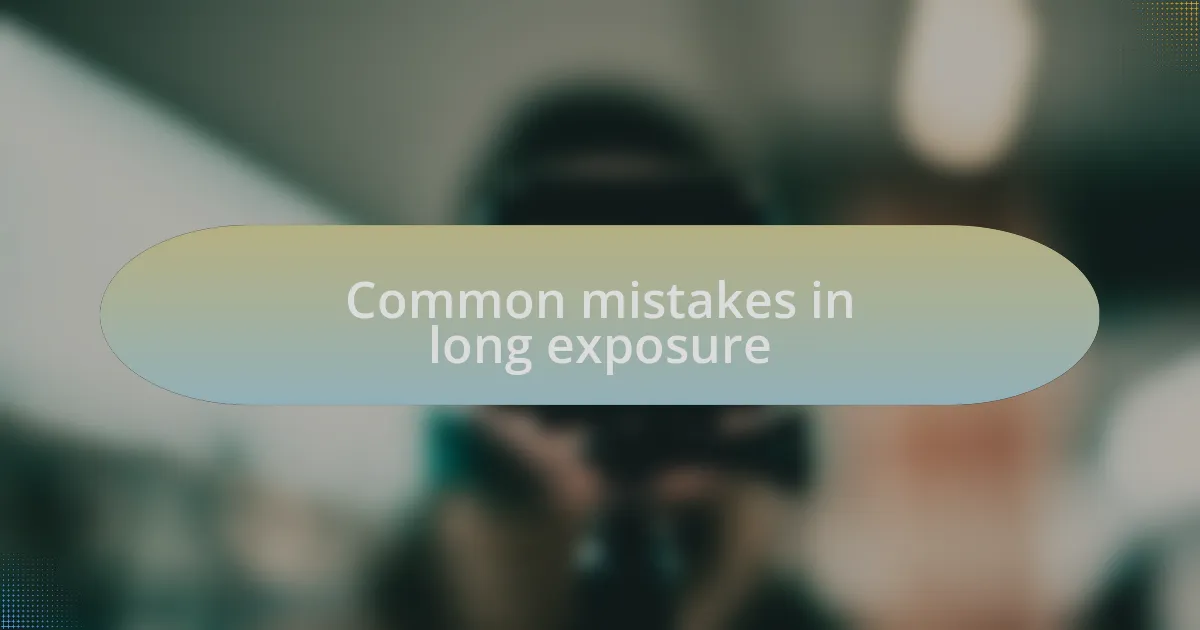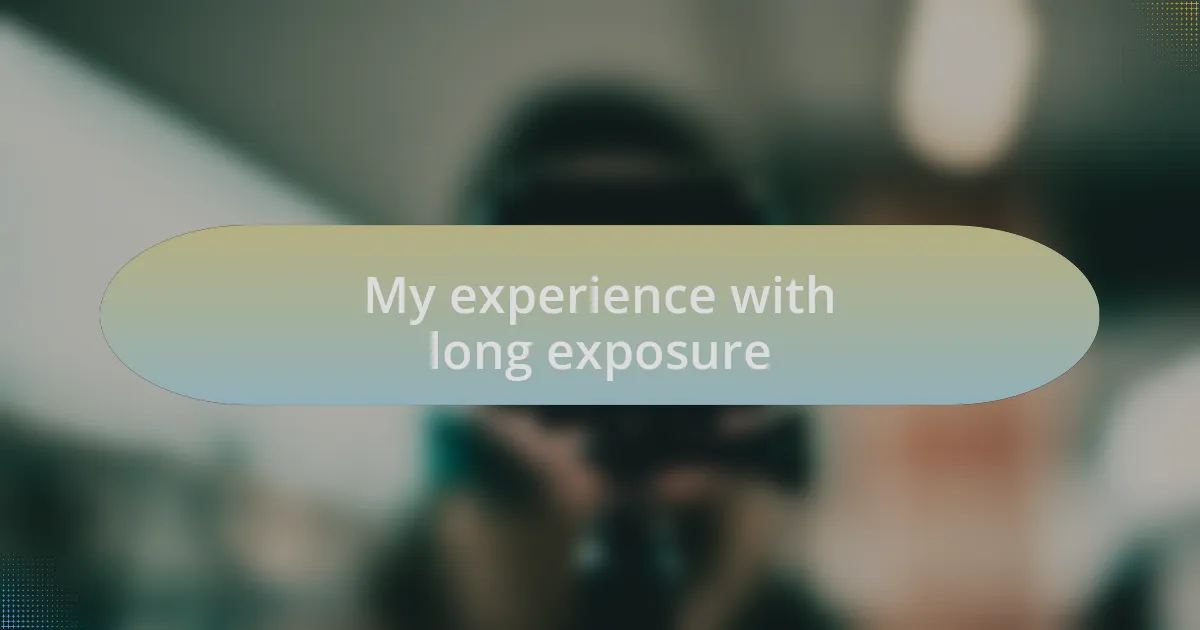Key takeaways:
- Long exposure photography captures dynamic movements, transforming static scenes into flowing visuals through light manipulation and patience.
- Essential equipment includes a sturdy tripod for stability, a neutral density filter for light control, and a remote shutter release to prevent camera shake.
- Key settings involve using manual mode, adjusting the aperture for depth of field, and carefully selecting shutter speed to encapsulate movement and emotion.
- Common mistakes include neglecting stability, using inappropriate filters, and misjudging exposure time, which can lead to disappointing results.

Understanding long exposure techniques
Long exposure techniques are all about capturing time itself—allowing you to see things that are often missed in a split second. I remember the first time I experimented with this method; it was thrilling to watch the clouds swirl and blend like they were painted in the sky. Isn’t it fascinating how a simple adjustment of your shutter speed can transform a static scene into a dynamic, flowing masterpiece?
One of the main principles behind long exposure is the ability to manipulate light. When I first ventured into this realm, I used a neutral density filter to allow more light into my camera for extended periods. It’s like giving your camera the ability to breathe longer in a bright environment. Have you ever thought about how the movement of water changes as you slow down your exposure? It can turn a choppy stream into a serene silk-like surface, creating a mood that resonates deeply with the viewer.
As I delved deeper, I realized that patience is key. I often found myself standing in the same spot for several minutes, waiting for the perfect moment. It’s an exercise in mindfulness, allowing you to connect emotionally with your surroundings. Have you experienced the same feeling of anticipation? Whether you’re photographing a busy city street or a tranquil landscape, the essence of long exposure lies in that quiet moment before the shutter clicks, capturing an ephemeral reality that can evoke strong emotions.

Equipment needed for long exposure
When it comes to long exposure photography, having the right equipment makes a considerable difference. A sturdy tripod is a must; I learned this the hard way after a series of shaky shots that rendered my efforts futile. The moment I invested in a robust tripod, my images transformed from blurry attempts to beautifully crisp captures, even in low light. Have you ever tried balancing on uneven ground only to have your shot ruined by camera shake? Trust me, stability is your best friend.
Another essential piece of gear is the neutral density (ND) filter. It’s been a game changer for me. I recall one evening by the ocean when I wanted to capture the movement of waves without overexposing the shot. Slapping on that ND filter allowed me to slow down my shutter speed dramatically, creating soft, dreamy water effects. It was then that I felt the power of light manipulation—have you ever felt that rush as your creative vision comes to life?
Lastly, a remote shutter release is invaluable. I remember standing in a bustling city, excited to capture the traffic trails during twilight. I used a remote to eliminate any vibration from pressing the shutter button, and it paid off. The resulting photograph, with its vibrant trails of light, was worth every ounce of effort. I often wonder, what moments would you capture if you had the perfect setup? It’s these small, thoughtful additions to your gear that can elevate your photography to new heights.

Basic settings for long exposure
To successfully capture stunning long exposure images, you need to start with the right settings on your camera. I usually set my camera to manual mode; this gives me complete control over the aperture, shutter speed, and ISO. I remember a night shoot where I forgot to switch from automatic settings, resulting in overexposed skyscapes. Have you ever felt that sinking feeling when your initial vision doesn’t come through because of a simple oversight?
One of the first settings I adjust is the aperture. I typically choose a smaller aperture, around f/8 to f/16, which not only sharpens depth of field but also reduces light entering the lens for longer exposures. I recall the first time I experimented with a f/16 aperture during sunset—transforming those illuminated clouds into a silky blur. It’s remarkable how a simple change can take your shot from ordinary to extraordinary. What adjustments have you made that led to surprising results?
Shutter speed is where the magic happens. I often start with an exposure of several seconds and adjust based on the scene. During a recent trip to a waterfall, I set the shutter to 10 seconds, capturing the water’s gentle flow while freezing the vibrant foliage around it. That moment made me realize how crucial timing is. Have you experienced the thrill of perfect exposure in your photography? It’s a constant balancing act that can encapsulate movement, emotion, and atmosphere in a single image.

Common mistakes in long exposure
Common mistakes in long exposure often stem from overlooking fundamental elements of stability. I learned this the hard way during my first attempt at capturing the Northern Lights. I was so eager to press the shutter that I neglected to bring my tripod, resulting in shaky images that lacked definition. Have you ever realized too late that a small piece of equipment could make or break your shot?
Another frequent pitfall is using inappropriate filters. I vividly recall a sunset shoot where I mistakenly selected an ND filter that was too strong, completely washing out the warm tones of the sky. The lesson I learned was clear: always test your filters and consider the conditions. Have you ever experienced the disappointment of a scene not reflecting the beauty before you?
Lastly, a common error is misjudging the timing of exposures. There was a time I overestimated the duration needed to capture the soft motion of waves, resulting in a blurred scene that looked chaotic rather than serene. Understanding how long your exposure should be is crucial for achieving the desired effect. Have you found the right balance in timing, or have you been caught in the excitement, leading to less-than-ideal results?

My experience with long exposure
Capturing long exposure images has been a journey of discovery for me. I still remember my first successful shot of cascading waterfalls; I was practically bouncing with excitement when I saw the silky smooth effect. There’s something magical about how time seems to stretch, transforming the chaotic rush of water into a serene blur. Have you ever felt that rush of adrenaline when a photo finally comes together?
In one memorable session, I was aiming to capture the stars swirling overhead. It was a chilly night, and I was fidgeting with my settings, perhaps a bit too nervously. Then, it struck me: the importance of patience and timing. Those few seconds of stillness before the shutter clicked taught me that anticipation is just as critical as technique in long exposure photography. Can you recall a moment when you realized that slowing down can lead to the best capture?
Another lesson that stands out involved a lively cityscape at dusk. I was trying to blend the motion of passing cars into the stillness of the buildings. The initial results were less than impressive; my settings were off, and I didn’t account for light pollution. However, after adjusting my settings and allowing myself to experiment, I eventually produced an image that resonated both energy and calm. Have you ever had to tweak your approach to finally get the shot you envisioned?